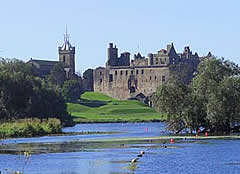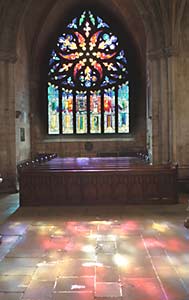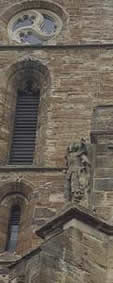The History of St. Michael’s Parish Church
"St Michael is kinde to strangers". So runs the motto of the Ancient and Royal Burgh of Linlithgow. St Michael is the patron saint of the town and, in the form of the ancient church of that name, he still stands guard above its inhabitants, both residents and strangers alike.
Although it is undoubtedly of earlier origin the first mention of "the great church of Linlithgow" is in a charter of 1138 in which King David I gifted it "with all its chapels, lands and other rights" to the Cathedral of St Andrews.
On 22nd May 1242, the Church of St Michael of Linlithgow was consecrated by David de Bernham, Bishop of St Andrews. Whether he was hallowing a new building or rededicating an established House of God, is not certain. What is clear is that the ancient kirk has for centuries been recognised as a place of worship and as an historical memorial without equal in Scotland.
In 1301 King Edward I of England arrived and requisitioned the Church as a garrison storehouse in which to house the war provisions required for his fortified palisade or "Peel".
After the Scottish Victory at Bannockburn, and the recapture of the Linlithgow fortifications, St Michael’s stood in need of considerable restoration.
Whatever reconstruction work was done in the 14th century was not long-lived as, in 1424, a great fire occurred which caused massive damage to the church and neighbouring palace.
Over the next 115 years St Michael’s was largely rebuilt although many of the old stones were incorporated in the new construction. Several local strategies were enforced to finance the rebuilding of the Kirk. Taxes were imposed on ale and leather and the money from fines for chimney fires or overpricing at the market also swelled the church coffers.
All the Stewart kings from James I to V donated revenue to St Michael’s "kirk werk" and not until 1540 was the church’s completion celebrated with the granting of a new royal charter and, with it, the right to appoint a town Provost. The man chosen was Henry Forrest of Magdalenes who had himself been active in the "kirk werk" and had personally ensured that the masons received their "drinksilver". They certainly earned it for under their expert hands emerged the beautiful Medieval church we have today. First the nave and transepts were transformed; then the chancel and the apse. Outside, twenty niches were filled with carvings of saints and, inside, each of the 8 bays was graced with an altar, attended by a staff of chantry priests. The solid, square tower was furnished with a magnificent stone crown, topped with a weathervane, bearing the favourite emblem of King James III. The church was further adorned with the erection of a beautiful oak roof bearing the arms of George Crichton, vicar of St Michael’s and later Bishop of Dunkeld. The ecclesiastical masterpiece which resulted was much favoured as a place of worship by the Scottish monarchs, most notably Mary Queen of Scots who was born in Linlithgow Palace on December 8th 1542 and was baptised in St Michael’s church.
The font which carried the holy water used to baptise the royal baby did not survive for many years longer. In 1559 the Protestant Lords of the Congregation arrive to obliterate all traces of the Roman Catholic religion from the Church. They smashed the holy water stoop along with the statues and altars. Occasionally fragments of this orgy of destruction are found in and around the church.
The first Protestant minister of St Michael’s was Patrick Kinloquy and his parish kirk was equipped with new galleries (including those for the town magistrates and the monarch) and a stone pulpit on the north side of the chancel. The town did try to uphold its obligations to its church and considerable money was spent on equipping it as a fitting House of God. However the church was also to be used for other purposes. In 1620 part of it served as a wood store while in 1645 it became for a brief time the University of Edinburgh when the students and professors escaped to Linlithgow form the plague-stricken capital.
The year 1646 saw the arrival of the roundhead troops of Oliver Cromwell. St Michael’s found itself incorporated in the general defences of the town with horses stabled in the nave and soldiers billeted in the triforium. By the time the Cromwellian army left Linlithgow the church had deteriorated and the heritors estimated that £1000 Scots was required to repair the roof and windows.
The 18th century church of Linlithgow followed the general Scottish pattern. It was dominated by the minister and his Kirk Session who rigorously guarded the community’s moral life and enforced fines for any breach of church discipline. The money collected was used to help the poor of the parish. The church was equipped with a repentance stool, on which any wrongdoer had to sit in full view of the congregation, and a set of jougs at the church door to chain up by the neck anyone guilty of repeated transgressions. The Kirk Session minutes are full of references to such moral lapses: drunkenness, adultery, whistling, working or washing clothes on the Lord's Day or not "keeping elders’ hours". A typical church service lasted up to four hours. A sand-glass was attached to the ministers pulpit in order to ensure that he spoke (extempore, for all notes were frowned upon) for at least two hours. Singing was led by the precentor and was unaccompanied as music in the church was frowned on and an organ was referred to scathingly as a "kist o’ whistles".
In 1768 a storm damaged the steeple and blew down the weather cock and in 1773 the "old bell" cracked and had to be recast at Three Bells Foundry at Whitechapel.
In 1808 there was a panic when it was discovered that the old ceiling beams were rotten at the ends and that the "crazy roof" was about to collapse. In 1812, the 16th century "Crichton" ceiling was removed and replaced with a plaster one, partly due to the fact that oak was unavailable due to the shipbuilding demands of the Napoleonic War. The interior was also remodelled: a "restoration" generally regarded now as an act of colossal vandalism, especially the removal of the old dividing arch between chancel and nave and the whitewashing of the walls.
It was a grim church which emerged in the early 19th century and they were grim times. On February 19th 1819 a Linlithgow Mortsafe Society was established to hire out a huge metal cage which was placed over a recent grave to deter the grave robbers from "resurrecting" the body and selling it to the anatomy lecturers in Edinburgh. In addition, a watchman’s hut was erected in 1823 against the south wall of the churchyard and a watch of three men was appointed to prevent any "nocturnal activities".
In 1820 there occurred one of the most unfortunate episodes in the history of the church. A report concluded that the old stone crown was in danger of collapse. Despite the reluctance of the town and the church authorities there was no denying the fact that something had to be done. Local tradesmen all agreed that the crown was too heavy for the tower. It was reluctantly decided that the only course was demolition and, in the summer of 1821, the old crown was removed.
In 1885 the splendid centre window of the apse was fitted out with stained glass in memory of Charles Wyville Thomson, the locally born oceanic explorer who died in 1882. It features a fleet of ships such as that which accompanied the explorer on his charting of the world’s oceans in HMS Challenger from 1872-76.
In 1992 the Society of Friends of St. Michael's Church celebrated the church's 750th anniversary with the installation of a new stained glass window in the St. Katherine's Aisle. The window, created by Crear McCartney is designed around the theme of Pentecost.
A 15 min video taking a look at our Biblically based Stained Glass Windows is available for viewing here



